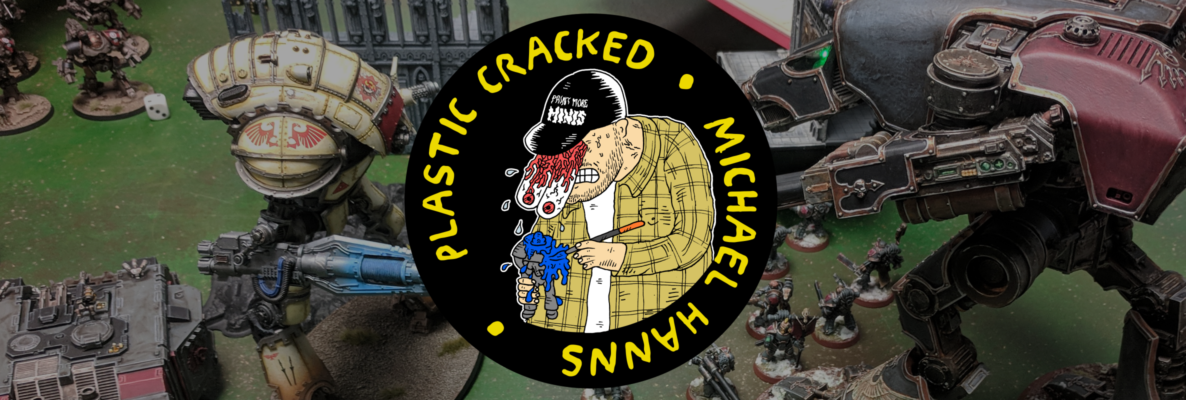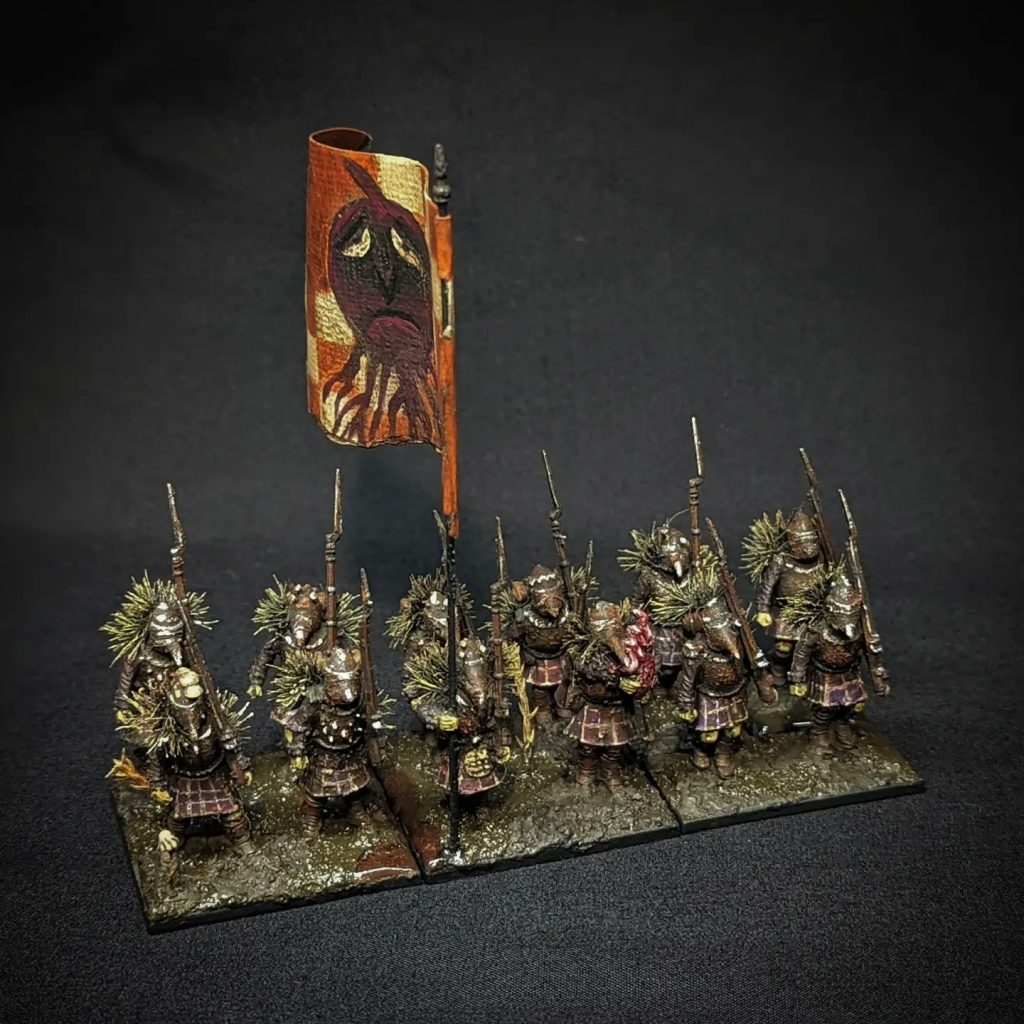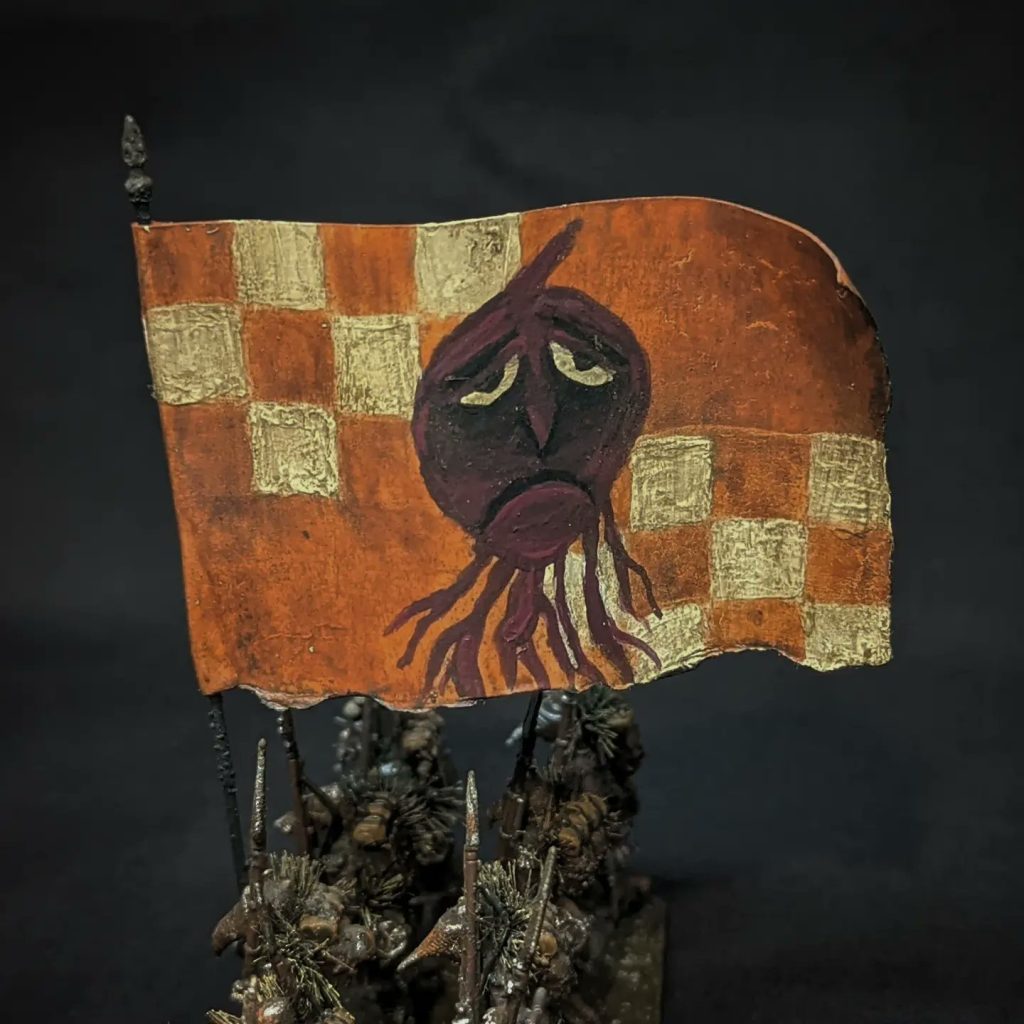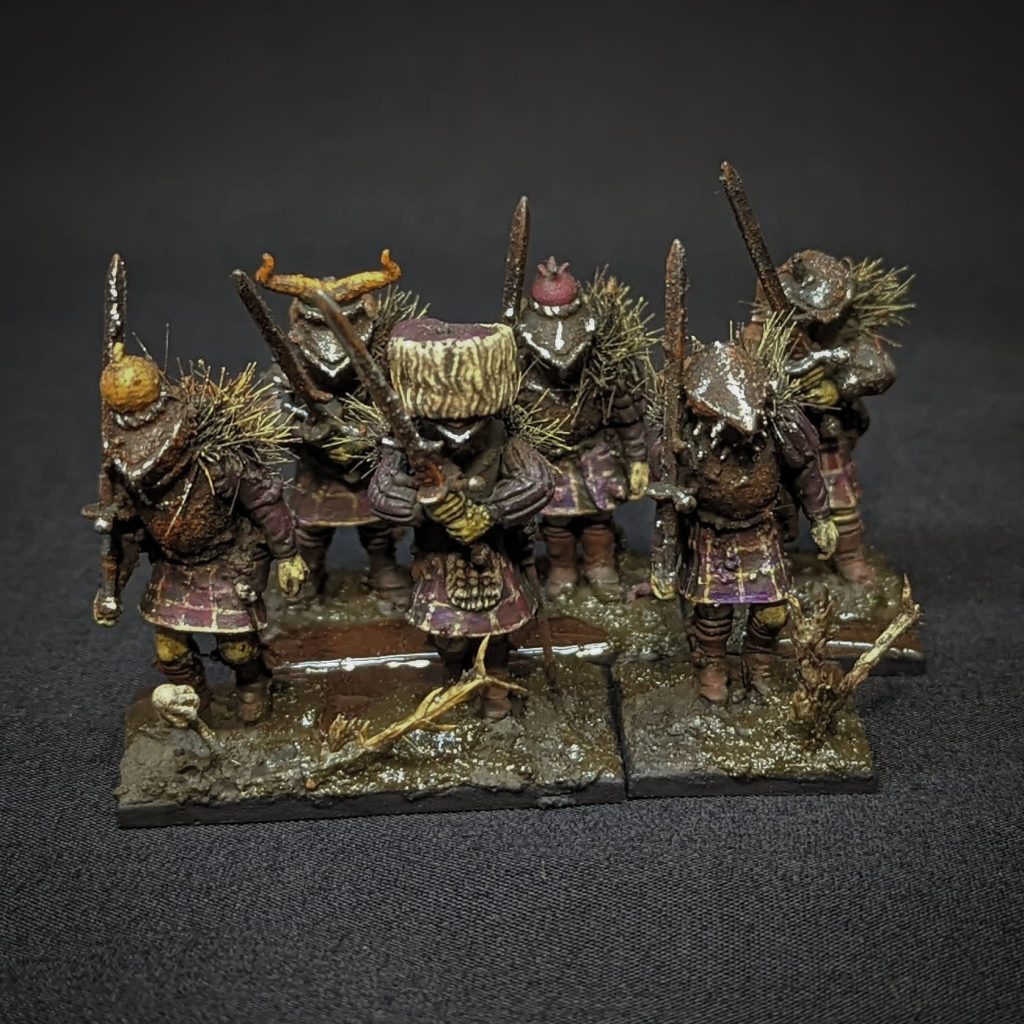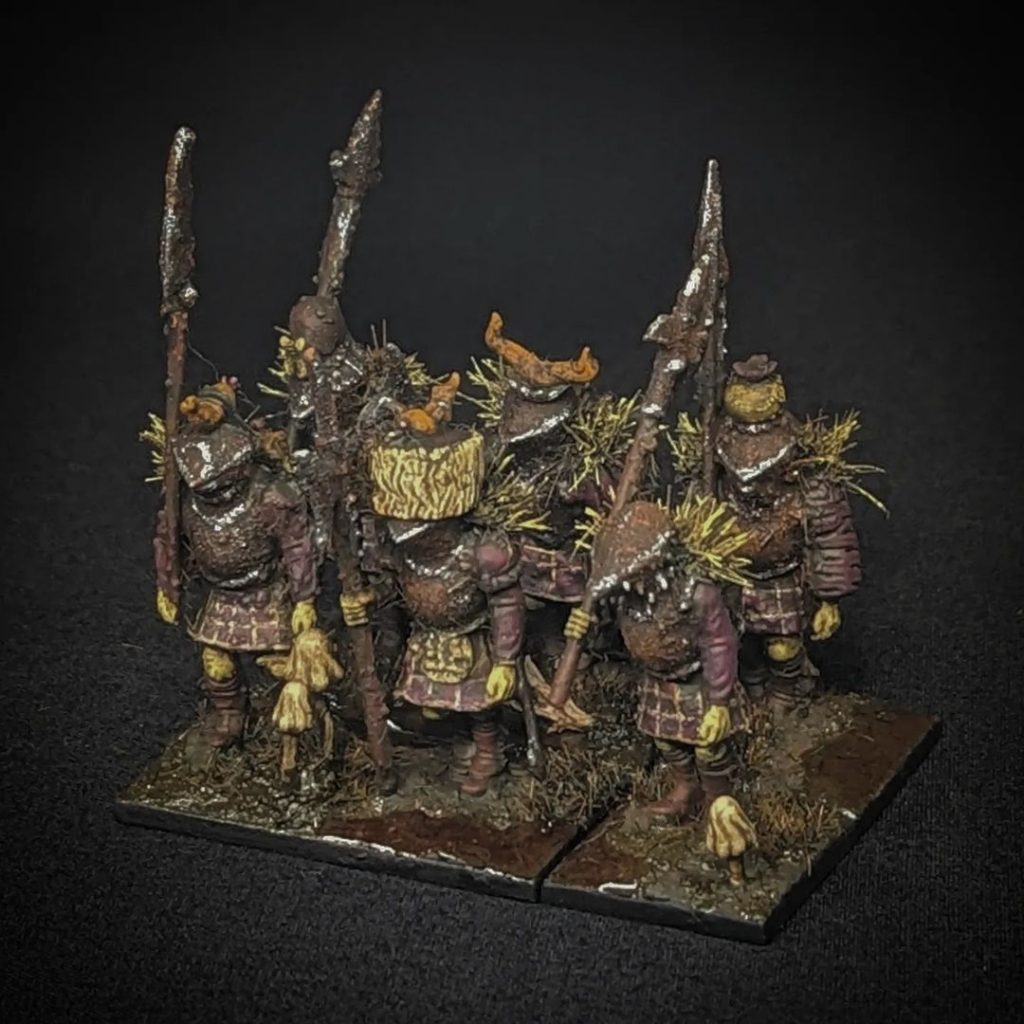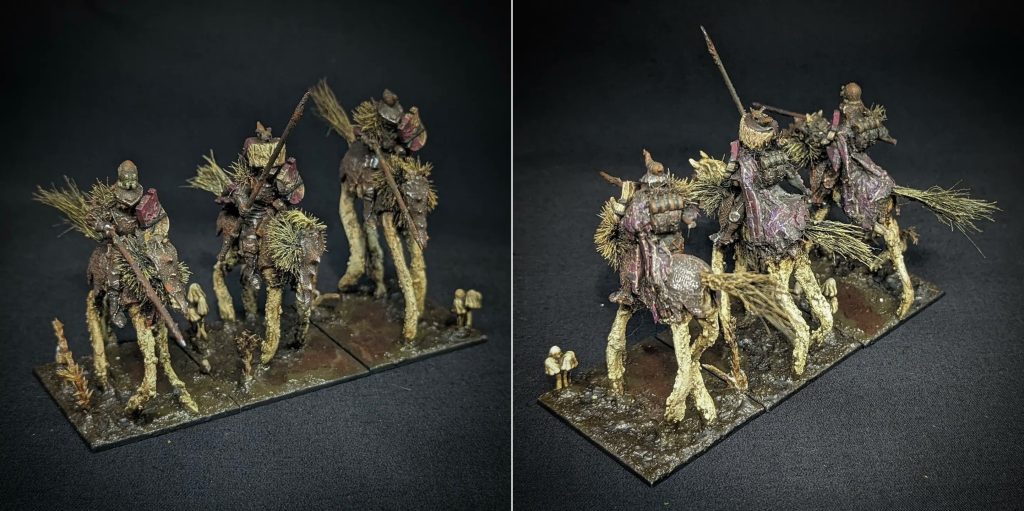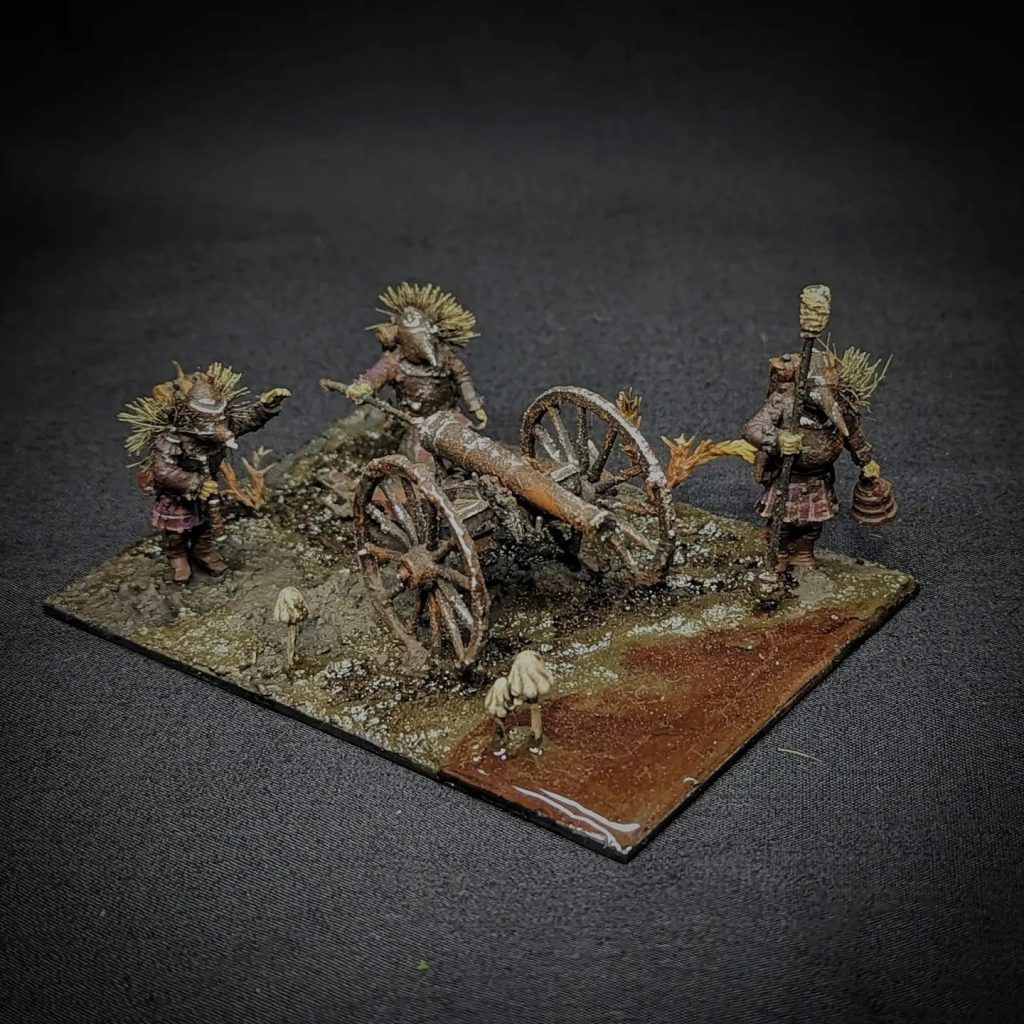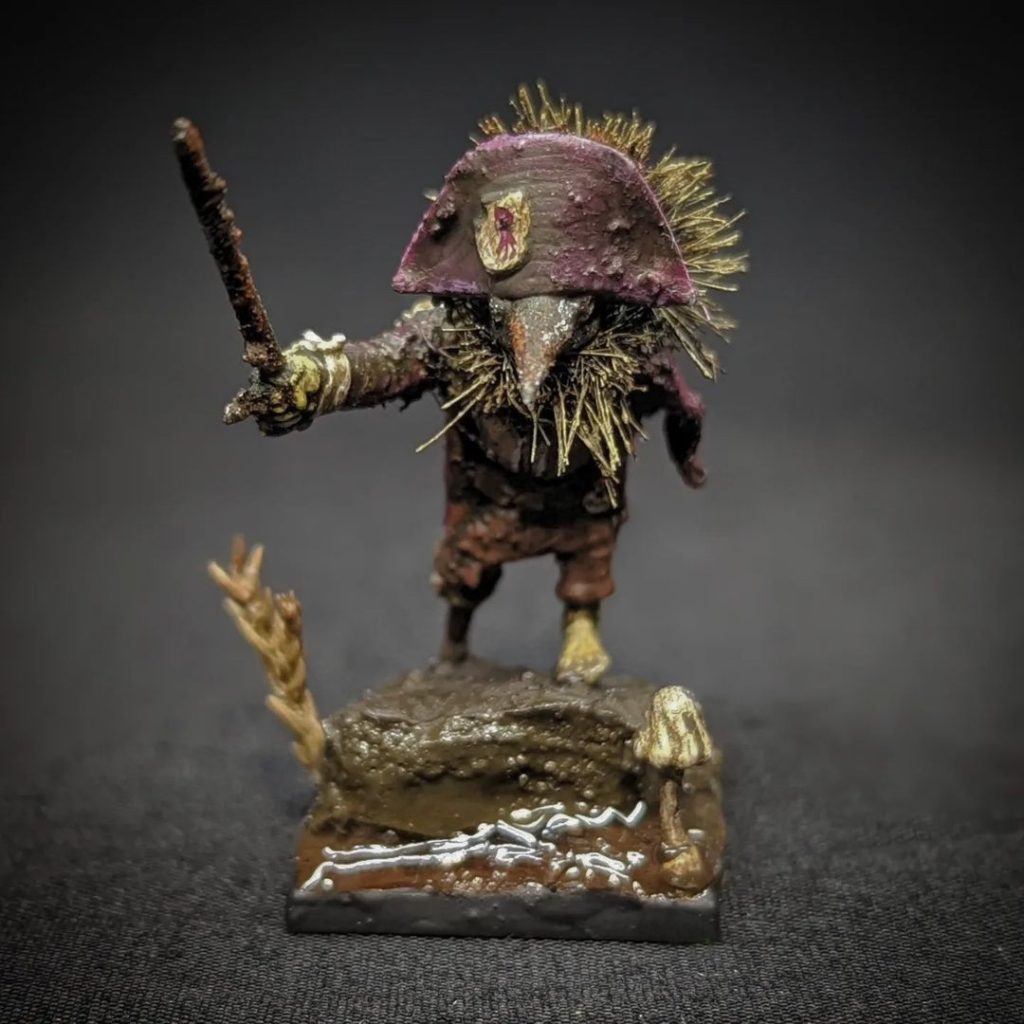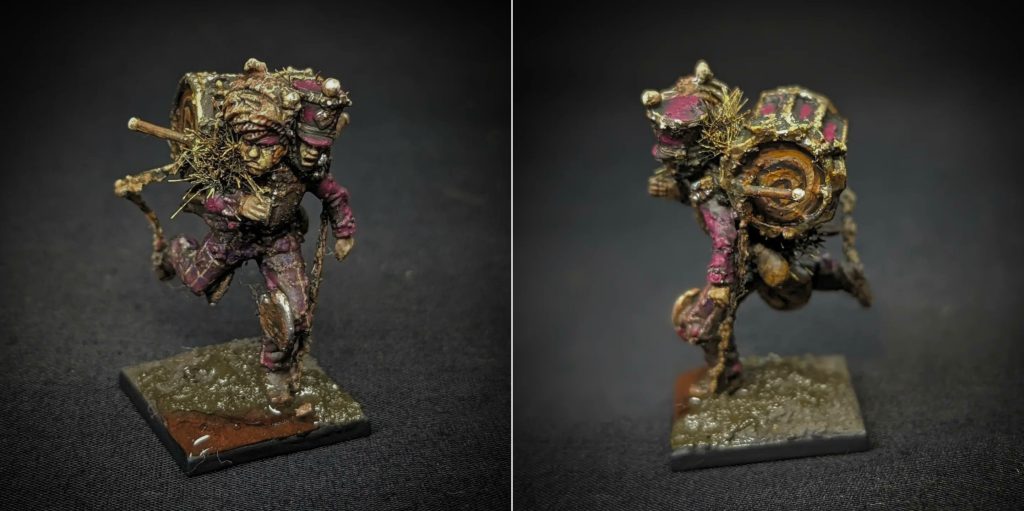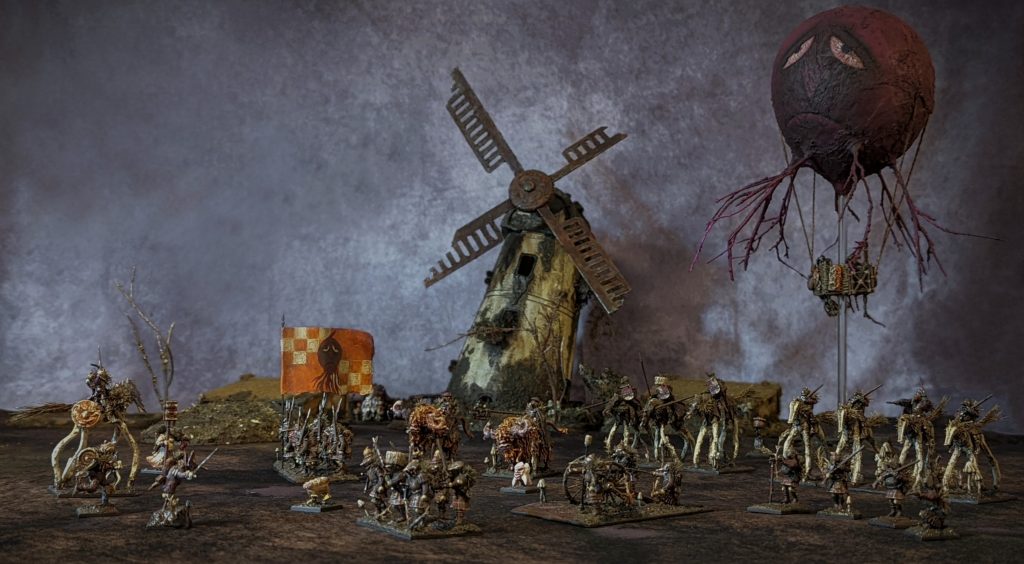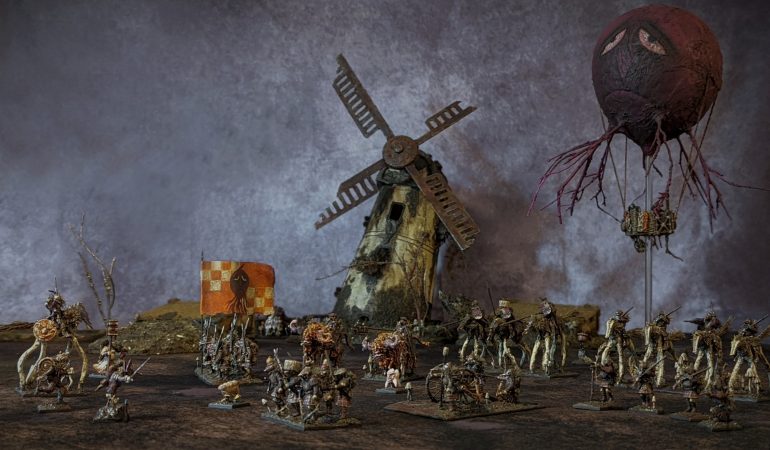
Back in Spring 2001, I was scrolling through Twitter – consuming the usual heady cocktail of drama and inspiring works of miniature art – when something magnificent caught my eye. It was a set of renders of about 10 different torso/helmet designs from an artist named SaintDecent for something called “Turnip28”. I had no idea what this Turnip28 was – I just saw what at the time I thought were cool, Plague Doctor style helmets. Not being a 3D printing kinda guy, I simply thought “oh, cool” and kept on scrolling.
Over time, I started seeing more and more references to this “Turnip28” popping up in my feeds. A lot of the time it was included in hashtag form like a synonym for ‘grimdark’ in 40K and Fantasy miniatures, but every so often I’d see something wholly unique. After a while, this guy Max Fitzgerald popped up on my feed with some pretty out there looking miniatures and 2D art – some pretty grim and evocative stuff. I gave him a follow and checked out his profile. This was how I first learned about Turnip28.
For those yet unacquainted with Max’s modern masterpiece of miniature wargaming, Turnip28 is a post-apocalyptic Napoleonic game set in a world where a malevolent root has reduced the world to a muddy mire following the end of the Napoleonic war. Small pockets of humanity have survived by consuming the root, which has all but mutated them and warped their minds. Cults are now popping up which venerate the root, picking up tattered banners and rusty muskets from a past age on their way to kick each other to death in the muddy land of Cist. It’s a Pike and Shotte kind of game with elements of Medieval warfare, the grim and gritty aesthetics of Mordheim and a genuinely funny, sardonic humour permeating through everything from the art to the flavour text to the very rules themselves.
Loads of people have already done a better job of explaining what Turnip28 is than I could, so have a quick Google or check out Max’s Patreon if you’d like to know more. Instead, what I’d like to share is what an impact this miniature movement has had on me personally.
I’ll be honest, Games Workshop hasn’t been doing a lot of late that excites me. While I thoroughly enjoyed their re-release of Adepta Sororitas (at least until my codex was replaced a year and a half later), the vast majority of releases for Warhammer 40,000 and Age of Sigmar have not been appealing to me like they used to. It’s become quite sanitised for my tastes, the miniatures somehow simultaneously a bit too refined and a little too cartoonish. Even many of the new releases for Middle-earth – while beautiful sculpts from a technical standpoint – have a certain ‘smooth’ quality to them that just sort of bugs me. We’re even starting to see some of that approach bleed into Games Workshop’s new focus on the Horus Heresy setting, with many of the new character miniatures releasing just feeling too over the top for my tastes.
This opinion isn’t something I feel comfortable sharing on my blog, as where possible I like to avoid coming across as the grumpy old grognard that I probably am. I love miniature wargaming – but more than that, I love Warhammer. I love the universes, the aesthetics, the art, the miniatures. Warhammer played such a massive part in my formative early teenage years and continues to live rent free in my head well into my 30s. That said, when I look back at my GW centric hobby of the past year – a Mordheim warband, two Inquisitor warbands, a substantial upgrade to my Skaven army for Warhammer Fantasy Battles and a few upgrades for my Heresy armies – there’s not a lot of new there. So much of what’s driven and excited me in the past year from Games Workshop has been old, long out of print games and miniatures that – while a little rough around the edges – had a certain flawed charm to them. Even in 2022, they still feel fresh, original and exciting for me to work on because they have a quality to them that feels somehow less manufactured, if that makes sense.
So, how does this relate back to Turnip? Well, the discovery of Turnip28 might be the first time in my adult life that I’ve stumbled upon something brand new in miniature wargaming that makes me feel the way that Warhammer did when I was a kid. Somehow, it’s fresh, familiar, disturbing and hillarious all at once. It hits the perfect balance between grim darkness and black humour, with neither extreme detracting from the other. It perfectly encapsulates everything that I love the most about Mordheim, Inquisitor – even video games like Dark Souls and Bloodborne – but it does so in a way that feels completely original. It has a sense of humour about itself that we haven’t seen from Warhammer since the days of Rogue Trader – yet it never comes at the expense of the grim, morbidity of the setting. The approach that Max and the rest of the Turnip28 scene have employed on their models perfectly captures the rugged scratch built aesthetics of the 90’s but does so in a way that feels undeniably modern, building upon decades of DIY Blanchitsu and Inq28/AoS28 work.
Beyond the wonderful art and modelling on show, the rules themselves are a thoroughly engaging read. Once again, Max’s sardonic humour permeates almost every line in the book. It’s not just little snippets of dialog and flavour text or even the humorously titled special rules such as Bowel Loosening Charge and Warty Charisma. It’s built into the very game itself. At the start of the game, your units deploy all smug and blustering but become increasingly panicked and prone to flee as the carnage unfolds. Every unit has the potential to blunder every order you give them, sometimes with spectacularly pathetic results. It’s a game about starving, halfway insane fanatics battling with Napoleonic gear they’ve scrambled together from the mud, fighting over the right to claim some inconsequential hill or a bog – and it plays exactly like this.
This style of humour and absurdity being written into the game, for me, helps a great deal to combat the ludonarrative dissonance I sometimes feel when playing a lot of tabletop wargames. I’m afraid to say that I’m one of those people who are prone to taking their miniature wargaming projects a little too seriously. I don’t like to make gag miniatures and I get a little upset when the more ridiculous aspects of Rogue Trader leak into Alan Bligh’s sombre vision of the Horus Heresy. This is in marked contrast to how I am at the table, where I’m not exactly Napoleon Bonaparte. I like my tabletop wargames to look engrossing and feel immersive – but there’s a limit to how seriously I can take a game of toy soldiers and dice. That being said, I still find it frustrating and immersion breaking when a Space Marine Captain can’t land a single hit on a squad of Grots. But that’s not the case with Turnip28. In Turnip, the ‘Weapon Skill’ equivalent stat is replaced by the far more pessimistic ‘Inaccuracy’ value. Everyone is meant from the outset to be a little rubbish and cowardly. When losing all of your battles is actually in keeping with the fluff of a Turnip28 army – that’s honestly kind of liberating.
I said it already, but it’s worth reiterating – Turnip28 is the first new invention of wargaming that has captured my imagination in the same way that Warhammer 40,000 managed when I was a kid. Since my first flip through the free rulebook, I haven’t been able to get it out of my head. I’ve been theorising kitbashes in my lunch hours, spending late nights converting and painting only to find myself laying awake in bed still buzzing with ideas. I’ve bashed together models from multiple historical kits, 3D printed parts, Warhammer bits and worked with everything from green stuff to tufts to twigs to paper mache to bundles of synthetic hair to resin denture teeth and temporary crowns. It’s not just the modelling that’s exciting though – painting in the aesthetic of Turnip28 has been completely liberating. Building miniatures feels like an exciting creative outlet rather than a chore to get through – while painting has become lightning quick and instantly gratifying. Instead of spending ages picking out lots of tiny details, the models are basecoated in a flash – giving me more time to spend on fun things like freehand banners and heraldry, enamel washes, creating different types of texture and all sorts of other weathering techniques.
My army for Turnip isn’t going to win any painting awards and it’s a far cry from my best technical work – but my God, has it been fun to put together. It’s been a tremendous reminder of why I paint minis in the first place – it’s a fun, relaxing way to forget about your problems for a while and disappear into your own imagination. I’m trying not to worry too much about making the basic things look perfect, but taking my time to work on the most fun and creatively rewarding parts of the process. It’s been an absolute joy and not one moment has been tedious.

So, you’ve decided to take the plunge and jump head first into the world of Turnip28. Great! Where do you begin? Well, first things first I recommend having a peruse of the Swolen Maglet. This lustrous tome is a great place to start picking up inspiration – it helps convey the tone of the game through art, short stories and comics as well as providing a good intro into kitbashing your own Turnip miniatures. It has guides for all ends of the spectrum here, from the classic Turnip28 combination of Agincourt Foot Knights and French Napoleonic Infantry all the way to Samurai or Fungus themed Turnip forces. There’s loads of great photographs of Max and other community members armies, plus even guides for making banners and other heraldry in your army. It was reading this guide and seeing the fungal and Samurai themed armies within that I got it in my head that my army should have some sort of unique distinguishing feature1. After failing to come up with anything original for a while, I started looking around my house and my neighbourhood, hoping to find something in my own surroundings to inspire me. It was then that I caught a glimpse of my wedding photographs and it finally hit me – kilts!
I did a little research online, trying to find suitable miniatures to start from – eventually stumbling upon Highlander Centre Companies plastic kit from Victrix. These were plastic, reasonable quality and came with all sorts of fun bits and pieces that I could utilise down the line such as bagpipes and even a kneeling pose. Good start. For the torsos, I knew I absolutely had to represent those Saint Decent Turnip28 torso/heads – they were what got me interested in this system in the first place after all. With a little bit of searching around, I was able to find Squidzilla Ink’s Etsy store, where a whole bunch of Turnip28 related models were available for print on demand at a fairly reasonable cost. This combination of Turnip28 chest/head pieces and Highlander Centre Companies really formed the backbone of the army and informed a lot of stylistic choices I made down the line.
Fodder are the main backbone of a Turnip28 army and make up your pathetic, cowardly line troops in units of 12. These I made up from Highlander Centre Companies with the torso cut off at the waist and replaced with a Turnip28 torso, then given Centre Companies rifle arms and a backpack. I did also buy some Perry French Napoleonic Infantry so as to mix up the backpacks a little, but also for some additional marching rifle arms as these were in comparatively short supply in the Victrix Highlander Centre Companies box. Once everything is together, I then glue a couple of tufts around the shoulders/backpack area and then fill in any gaps made in the assembly using some mud texture paint. This is not only considerably faster than using green stuff, but it also gives a little extra – and desirable – texture to the miniatures themselves that adds to the grubby look and feel. Better yet, if I discover any mould lines that I missed during assembly, a little texture paint works well at this stage as a quick solution to hide any such imperfections. It’s quick, painless and actually kinda fun compared to plugging gaps with putty.
Since Fodder were the kind of unit that will appear in just about every Turnip28 game, I thought this would be a nice place to add a nice big company standard to the unit. This has no effect on gameplay whatsoever, but it’s really fun to paint and adds a touch of flash to an army that is otherwise rather speedily painted. On the advice of the Swolen Maglet, rather than using a long, flimsy plastic banner pole, I instead ordered some 1mm diameter brass rod which I attached to the hand and base of the miniature after painting. This not only gives it extra rigidity, but it also allows me to use a much longer pole, enabling even more ridiculous and ostentatious banners. Good stuff.
The other two types of infantry in Turnip28 are Chaff and Brutes. Chaff are a smaller, 4 model unit of skirmishing sharpshooters, which I decided to represent with more varied poses and fancier rifles. For these, I picked up a box of Warlord Games Pike and Shotte – whose rifles are a little chunkier and flashier than those of the Victrix or Perry miniatures. They’re also missing bayonets, which I thought was befitting a unit who you really probably do not want to be charging into combat. I assembled two of these in ‘on the move’ poses, with legs that appeared to be moving briskly and holding their rifles across their chests. The other two I assembled in firing positions – one of which I built using a set of crouching legs, the other I put on a double length base and assembled using a sort of tripod to steady the end of the rifle on. Thankfully, Turnip28 has absolutely no rules whatsoever on basing aside from a rough minimum/maximum, so it’s perfectly legitimate to give a miniature a bigger base if the model calls for it.
For Brutes, I wanted these guys to have somewhat bulkier armour and some big two handed weapons. Thankfully, there’s a second set of Turnip28 torsos available with frogmouth helms – chunkier, pointy faced ones that might imagine on a knight. I bashed these together with sets of arms from the Warlord Games Landsknecht Zweihanders. These have big two handed weapons and puffy shoulders which befit the slightly more elite status of Brutes. I honestly thought I’d like the ones holding the swords two handed the best, but something about the slumping poses and dangling arms of the models marching with their swords just looks absolutely perfect – I’ll be leaning harder on those poses should I find myself doing another unit of these.
Oh wait, I did do another unit of these – with halberds this time – and I did lean harder on these poses. Cool.
With the infantry taken care of, it was time for the Cavalry – and for these I started with the Bastards.
Okay, so a couple of things are going on here with the Bastards, the most notable of which being the horses. To create these monstrosities, I started with a box of Perry Agincourt Knights, lopped off their legs, drilled a hole into each of the stumps and inserted some flexible wire with a little super glue to hold it in place. Once all four legs were replaced by wire armatures, I’d pose them in a wonky shape that looks roughly like a wobbly trot and trim them to a roughly even size with my clippers. Then I’d mix up a 50:50 mixture of Milliput (for strength) and Green Stuff (for flex) and wrap it around the wire, smoothing it against the body of the horse. The finish of the putty doesn’t need to end up especially clean or smooth for reasons that’ll become apparent shortly, but it does need to be fairly consistent in shape and girth. With the legs done, I then went onto the heads – these were the necks and ears of the original horses, with the faces chopped off and replaced with the face of a Seeker of Slaanesh steed. This seemed like a fittingly weird face for a horse, with a muzzle that roughly resembles a parsnip. Better yet, there were two variants here – the regular heads and armoured ones from the Chariot kit, the latter being especially suited my tankier Bastards. Replacing the head wasn’t a super complicated job, really – all I had to do was chop the face off the horse and replace it with the Seeker, then add a little green stuff to fill out the neck. Just a quick and dirty gap filler though – once again, the finish/texture on the neck doesn’t matter too much at this stage.
With the wonky legs and parsnip faces finished, my horse was starting to take shape, but we weren’t all the way there yet. The last step was adding a little rough turnippy texture. First of all, I snipped off the plastic tail and replaced it with a bundle of Woodland Scenics Natural Straw. Not only does this balance out the height of the miniature with a more proportionally appropriate tail, but it gives it a kind of weird looking rigidity and adds a little more natural texture to the miniature to boot. Additionally, I took a couple of tufts and applied these around the neck of the horse – creating a kind of rootish mane to match the kind growing out of the infantry, as well as cover up any damage or partial reins left from replacing the horses head. After gluing on some chainmail barding to the sides of the horse, the last step was, of course, some mud. I applied this all over the legs, as well as covering any gaps in the body or exposed green stuff. When painted, the texture really gives the long, wobbly legs a kind of warty mushroomy vibe which I thought really suited the aesthetics of Turnip.
With the horses finished, I glued a set of the Agincourt Knight legs to the saddle and a little chainmail barding to the front and back of the horse. On went a 3D printed Frogmouth Helmed Turnip Knight torso (as on my Brutes) and then I stuck on a pair of arms – one carrying a lance and the other holding the reins. As I was unable to use a kilt on these miniatures, I decided the best way to continue the plaid theme across these miniatures would be a fly plaid over the shoulder. I made this from a sheet of kitchen roll torn into a small square, folding the corners like a fly plaid and attaching to the shoulder with a tiny bit of super glue. Afterwards, I draped the plaid over the shoulder of the miniature and applied a little water with a brush to weigh it down and give it a bit of weight to help mould it over the miniature. Once I was content that it was sitting naturally, I covered it with some texture paint to seal it in place. As a final touch, I had some 3D printed Turnip28 shields – these come in a variety of shapes, one of which is a jousting shoulder shield. This really helped add a little rotten pomp and pageantry to the miniature overall. A backpack, a pair of tufts and a little mud later and my Bastards were ready for painting.
The other kind of Cavalry in the army is a unit of four Whelps. These are meant to be lighter Cavalry with a bonus to their Inaccuracy on the charge, but who also suffer no penalties for moving and shooting. I liked this idea of a fast, harassing force here as a counterpart to my melee focussed Bastards, so I built these carrying the same fancy Pike and Shotte Rifles as I put on my Whelps. For the ‘Leader’ of the squad, I went for more of a ‘pistolier’ vibe and gave him a pair of duelling pistols.
To help differentiate them from Bastards – besides the guns – I gave them the standard torso/helmets that I used on the Fodder, as well as using the unarmoured Seeker heads from the Seeker Cavalry models. I also gave the horses slightly shorter legs, and tried to pose them in more of a ‘wonky gallop’. I like the idea that maybe these lighter horses are Mares as opposed to having Stallions for the Bastards, so I also gave them one less tuft on their necks as an extra differentiating factor.
The final type of non-Cult Follower in a Turnip army is the Stump Gun. It’s… Well, it’s a cannon.
Not too much to talk about on this one. I made mine from the British Napoleonic Foot Artillery kit from Victrix on a large Rendera base. The Cannon I built from the kit exclusively, while the crew were made from the legs of a Highlander Centre Companies model, with a Fodder chest/helmet and a set of arms from the cannon crew. Pretty simple stuff, really, but it looks cool. Who doesn’t love a bit of heavy artillery?
The Commander/Hero/HQ models of Turnip28 are called ‘Snobs’. In a standard sized game, you’re expected to bring three Snobs – a Toff and two Toadies. The Toff is your army leader – a charismatic leader or religious figure who mustered the warband. The Toadies are your snivelling Sub-Commanders, fighting among themselves to try and raise their own station. Snobs fill an interesting role in Turnip, able to issue orders to help command and organise your Followers on the battlefield. This is not HeroHammer – their individual profiles are kinda crap. They’re more suited to bossing others around than doing any fighting themselves. Officially, both profiles have a small pistol for shooting and a close combat weapon that confers no bonuses; as such, it’s kind of left up to you to model them however you want.
The Commander of the 22nd Bloody Beet Brigade is a man known as the Bloody Bonce. Whatever The Bonce lacks in charisma or battlefield acumen, he makes up for it with it with sheer longevity. Perhaps his greatest achievement – and the reason for his nickname – is that he has survived at least three separate mutinous attempts on his life. Despite two bullets and a hatchet to the back of the head, the Bonce still lives to fight his holy crusade in Cist – much to the dismay of his disillusioned followers.
For the Bonce, I built him pretty much as if I would a Bastard – minus the barding on the horse (I ran out) or the jousting shield. Instead, I took one of the larger round shields and slung it on the side of the horse. For his body armour, I just used an Agincourt Knight chest and attached a helmet from a Putrid Blightkings kit on top to give him a bit of a fancier helmet with a unique look to the rest of the army. Finally, I’d drill a few small holes in the helmet for bullet wounds and cut a little opening on the top, then glued in a small warhammer from the Agincourt Knights kit in place, like the weapon was stuck in his head.
Second in command of the 2nd Bloody Beet Brigade is Lieutenant Titch. I don’t really know why, but I really wanted a little guy as my 2nd in command – so Titch was kitbashed together using bits from the Malifaux Ulix Turner miniature that my dog chewed. It’s a great model for kitbashing something like this – the jacket, the pocketwatch and the amputated leg all scream ‘Turnip28’ to me. In practice, the miniature wasn’t actually quite short enough to sell the effect, so I chopped him up at the waist and shortened his legs just a little touch more. The arms and head were too damaged from the chewing to salvage, but that was all fine as these would be getting replaced anyway. On went a 3D printed Toff head that came with my Fodder torsos and I stuck on a commanding looking sword arm. I mulled over a few possibilities for his other arm, but with the long jacket, short legs and beaky helmet, I couldn’t help but notice the miniature looked a little bit like a penguin. To that end, I decided to lean into the amputee story and gave him an empty jacket sleeve flapping in the wind at his side. This also has the benefit of looking a bit like – you guessed it, a penguin flipper. I really love how this guy turned out, probably even moreso than The Bloody Bonce.
My third and final Snob is Sergeant Mangum and.. yeah, I don’t really know what I was thinking with this one. I was listening to a lot of Neutral Milk Hotel as I was building this army, which is where the whole two headed boy thing came from. The idea wasn’t fully formed however until it occurred to me to put a drum on his back and paint it like a snail shell. I dunno, something about this concept just feels like peak Turnip to me. The body and legs are all Perry French Napoleonic Infantry, while the drum on his back I think came from my Pike and Shotte kit. I had a bit of weird looking glue or string or something sitting next to me at the time, so I connected a set of drumsticks from the same kit to the drum and attached these to his feet with the string. A pair of green stuff cymbals on his knees and some skanking arms later and we had ourselves a Snob.
So, that about covers the construction of my first wave of Snobs, plus each of the basic Follower units for my Turnip army. What about the painting?
Most of the whites on shields, tartans, fur hats and horses here were painted with Citadel Pallid Wych Flesh while the purples are all Citadel Barak-Nar Burgandy layered with Citadel Screamer Pink. The skin tones were all base coated in Vallejo Dead Flesh. The oranges are mostly Vallejo Orange Fire and/or Citadel Fuegan Orange shade. The browns are Vallejo Dark Fleshtone and Leather Brown, while details such as straps are picked out in Charcoal. Generally speaking, I’d basecoat everything in these colours, apply a generous coat of Streaking Grime, wipe it off with some mineral spirits and then come in afterwards to do the metallics. These were Army Painter Gun Metal, coated with Typhus Corrosion, drybrushed Ryza Rust and washed Reikland Fleshshade with the edges picked out with Army Painter Shining Silver. And that’s it, pretty much. There was a little bit of nuance here and there – the tartan, for example, took a little bit of effort to get straight lines of white and highlight some areas with brighter Screamer Pink. There’s a little bit of Vallejo Stormy Blue in the tartan in places where I remembered to do so as well, but it’s not super consistent. While some mistakes were irredeemable – thick or inconsistent white lines in the tartan, for example – generally I could knock out the plaid pretty quickly and let the Streaking Grime kind of cover up some of the imperfections. The bases were equally quick, using AK Interactive Muddy Ground layered with AK Interactive Wet Ground for the most part. I’d leave a few ‘puddle’ areas where I’d brush on a little Burnt Umber pigment then made some puddles using UV resin. For a final bit of texture, I also put down some 3D printed mushrooms (Pallid Wych Flesh washed with Streaking Grime) and some dried out twigs from a bush that was recently trimmed in my neighbourhood.
I tried not to get too hung up on imperfections or going crazy with layering and highlighting on this army. Instead, I attempted to focus more on creating moody, grimy looking miniatures with an emphasis on texture variation rather than clean edges. That’s not to say there wasn’t any highlighting in there, but it was fairly sparse and mostly around the edges of metallics or more colourful areas that were looking a little bit too flat or plain. I suppose the point of this project was to really focus on the things that I enjoy and minimise the amount of ‘chore’ involved in creating an army. Instead of being boring slog of following step by step instructions and filing mould lines, assembly became the main focus of the creativity on this project – with loads of fun kitbashes and trying to build something unique within the confines of the established setting. Painting was quick and instantly gratifying, as I was able to knock out units like the Chaff from start to finish in a refreshingly short space of time. Instead of spending hours picking out and cleaning up edge highlights, I was slapping colours down trying to make something impactful at a glance, taking my time on the mini little freehand pieces across the army. I spent a whole evening painting the sad beet on the company banner on my Fodder – and it was pure joy from start to finish.
I’ve got a whole lot more to talk about with regards to my Turnip28 army, but this post is already getting a little overlong as it is. If you’d like to learn more about my Cults units (such as the hot air balloon or highland cow cavalry featured in the army shot above) or terrain projects (such as the windmill or sunken houses) then check back soon for parts two and three of the 22nd Bloody Beet Brigade.
Until then, thanks for reading and happy wargaming!
1 Gimmick.
